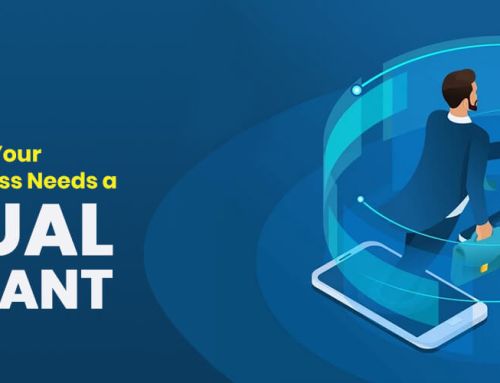If you want accurate, efficient, and trustworthy market insights, the CATI survey is something you should definitely consider. Among all of the methodologies available, CATI is one of the preferable methods that stands out as a balanced approach that combines the human touch of a live interviewer with the power of computer technology.
CATI has the benefit of real-time data collection as well as data security and management. Join us in exploring what CATI means, how it differs from IVR, its workings, benefits, limitations, and real-world applications in various industries.

What is CATI in market research?
Computer-Assisted Telephone Interviewing, or CATI, is a market research methodology where phone interviews are conducted with the help of computer software. The interviewer calls up a person, reads from a questionnaire, and records the answers received into the software in real time.
CATI involves computer software the way in-person surveys use apps on tablets or smartphones. It combines the personal touch of the human interviewer with the efficiency of computerized data collection.
What is IVR vs. CATI?
The main difference between Interactive Voice Response (IVR) and CATI is that IVR is completely automated, where an automated system handles inbound and outbound calls by asking respondents questions through pre-recorded messages. The respondent answers the questions either by speaking or pressing numbers on their phone’s keypads.
In CATI, on the other hand, trained interviewers place calls to respondents and record their responses to a questionnaire into a computer-based survey.
CATI surveys are also more expensive than IVR, but they produce better data quality and information.
How does CATI work?
In a CATI survey, all an interviewer really needs is a phone, a computer system, and an internet connection. The respondents contact information is automatically displayed to them in the CATI interface. All the interviewer has to do is follow the script – including the introduction of the survey, the questionnaire, and the conclusion – displayed on the screen and record the respondents’ answers.
You can design the questionnaire and the survey logic for a well-structured data collection. That way, the logic will use the responses and customize follow-up questions, so irrelevant questions are removed.
CATI software usually can place calls to respondents one after the other, automatically; some can even record the responses automatically.
Here’s an example of the workflow of CATI in market research:
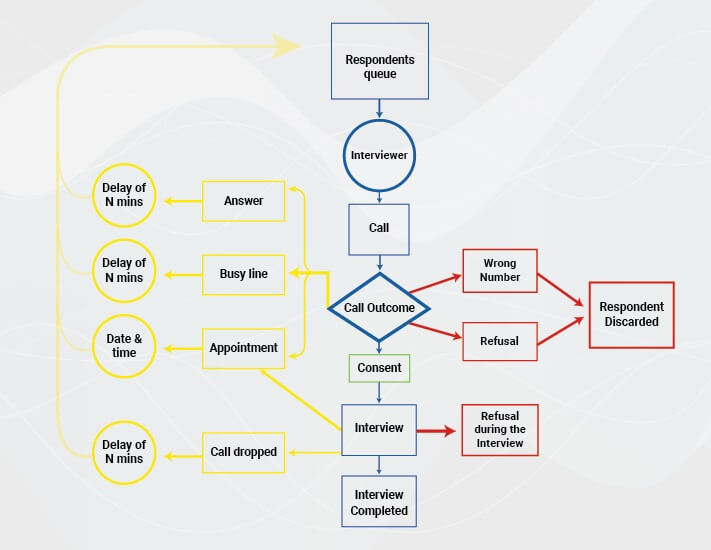
The benefits of using CATI in market research
There are many benefits to using the CATI methodology, and they include the following:
- Cost-effective: Because CATI is basically a telephone survey, it is much cheaper than face-to-face and other traditional interviews where there are travel and logistics costs. CATI surveys can be conducted remotely, even by virtual assistants who work from home, reducing various overheads for you, like rent.
- Real-time responses: Since CATI surveys are conducted live, you get immediate (or real-time) responses to your questions. You can also probe deeper to clarify responses immediately so that accurate data is entered.
- Faster data collection: Also, since most of the work is done by computer software in CATI, each survey can be completed quickly, so you can collect a lot of data in a day. Even if a survey is not completed—i.e., if a respondent drops the calls or refuses to continue with the survey – the software will immediately call up the next number. It will continue to do so till the interviewer has met their target for that period, meaning there is no loss of time between interviews.
- Data accuracy: CATI software has built-in checks and validation protocols that alert an interviewer if there are errors in data entry. Therefore, there will be fewer illogical data, ensuring accuracy and better quality. Also, the software records all phone interviews, and a supervisor can monitor the calls in real-time. This makes it easier to catch any biases on the part of the interviewer or the respondents.
- Qualitative feedback: CAT surveys are perfect when you are soliciting feedback from respondents because you can have a conversation with them, explain your questions if they have doubts, and clarify their feedback if you have doubts.
- Data management: All survey data are stored in the CATI software, so it is easy to access and process the necessary information when needed.
- Better response rates: Since the interviewer directly calls us the respondents and enters the data themselves, the response rates are much better. In online or email surveys, you may not get any responses, or the respondents may send in their replies very late. Moreover, not everyone will have constant access to their email or stable internet connections, but almost everyone has a phone these days.
- Adaptability and flexibility: CATI surveys can easily adapt to changes in a survey’s design, language, or type of respondent. The systems can make simple questionnaires or even complicated ones that have branching logic (where only questions relevant to the respondent pop up). They can also create interview questions in the language of the respondent. Because CATI surveys are so flexible, researchers can easily tailor their approach based on the needs of each study.
- Data privacy and security: CATI systems store data securely, and only authorized personnel can access certain data, depending on their authority. Therefore, the collected data is kept confidential, and your brand (or the outsourced third-party agency) is compliant with data protection regulations.
Mixed modes of data collection: There are many modern CATI systems that combine telephone surveys with online surveys. This combination lets you leverage the advantages of both research methods, giving you more avenues of data collection, therefore higher response rates.
Limitations of CATI market research
Although the CATI is very beneficial for conducting market research, there are some disadvantages you should be aware of before opting for this methodology.
- Respondents tend to be less honest in their responses over the phone. It’s usually because they want to come across as polite over a call as they are not as anonymous when compared to an online survey. They often give higher ratings (if the call is about feedback) even if they feel like the rating should be lower. Additionally, they’ll be conscious about whether the people around them can hear their conversation during the interview.
- People today are less patient and may not have time for surveys that will take 15 to 20 minutes away from whatever they are doing. If a respondent feels like the interview is going on for a little too long, they’ll just drop the call without any warning.
- Many times, CATI calls go out during the day, when people are working. So, if they are too busy or they don’t want to be interrupted, they’ll ignore your calls, leading to lower response rates. This is where it can be beneficial to use mixed modes of data collection. Or you could simply call at a time when it is almost guaranteed that the respondent will be free.
- CATI has a limited geographical reach compared to online surveys.
- The survey structure is limited, as you can’t show images or list out attributes without the respondent losing track of the conversation or getting bored.
- CATI surveys can sometimes be misunderstood for telemarketing, and the respondent might drop the call or come off as hostile during the conversation.
What features should I look for in a CATI software system?
Some key features you should look for when choosing a good CATI program are:
- Automated dialing
- Real-time data entry
- Logic-based questionnaires
- Data validation protocols
- Data privacy compliance
- Integration with online surveys for mixed-mode data collection
Some examples of CATI software
Voxco CATI
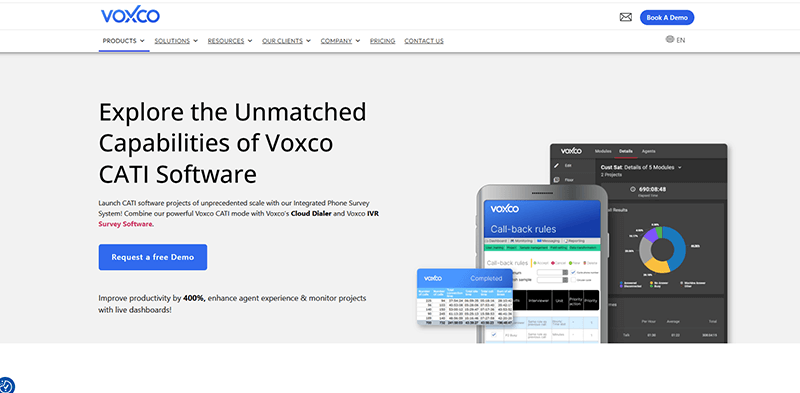
Key features:
- Integrated phone survey system: online, CATI, IVR, or Offline
- Call management
- On-premise or cloud hosting
- Call barging
- Quota management
Pricing: Custom
Askia
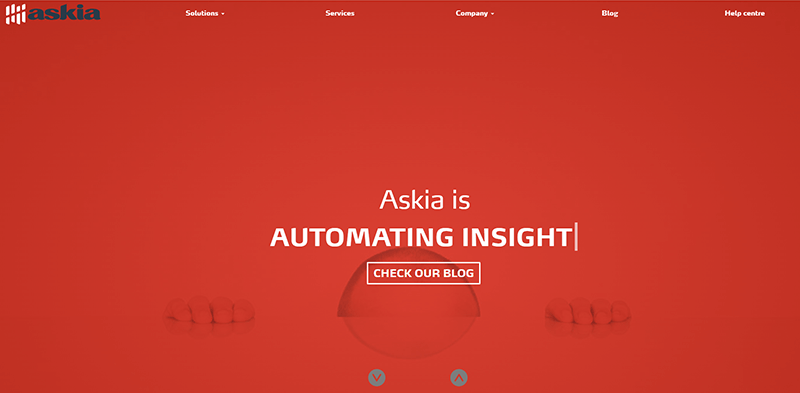
Key features:
- You can assign sample files, link to external databases and run various reports
- Supervisors can easily review progress and carry out performance checks on call agents
- Automated call recording
- Remote listen-in
- Extended statistics
Pricing: Custom
IdSurvey
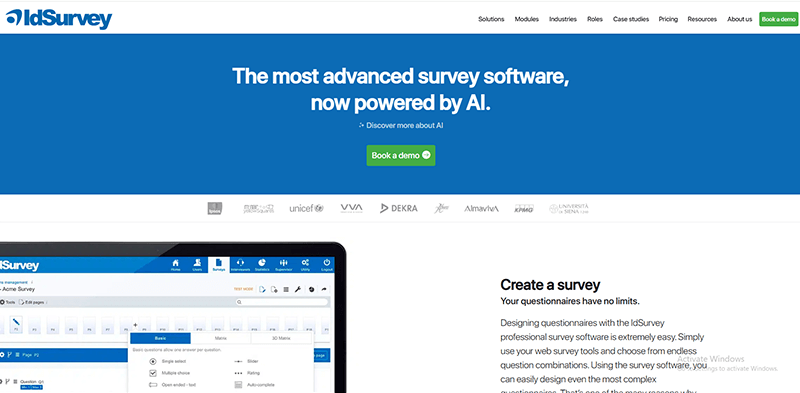
Key Features:
- Built-in softphone
- Click to dial and predictive dialing
- Supervisor dashboard for real-time monitoring
- CATI interviewer rules
- Supervisor and interviewer chat
Pricing: Request a quote
Forsta CATI
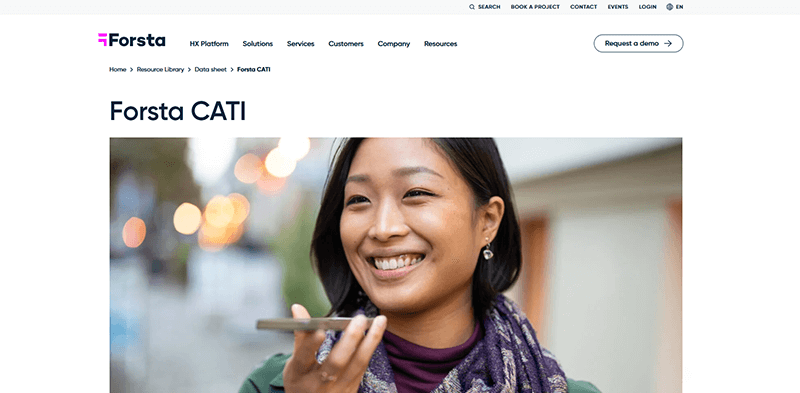
Key features:
- Automated dialing
- Real-time dashboards
- Management of remote workers
- Connection with third-party dialers
Pricing: Custom
Use cases: Applications of CATI surveys
The CATI methodology is used in a number of different ways:
In the healthcare industry:
- Patient satisfaction surveys: to identify areas in healthcare services that need improvement and guide healthcare providers in implementing the changes that patients require.
- Data analysis: to gather data regarding patient demographics, their healthcare utilization patterns, their satisfaction levels, and their decision-making processes.
- Evaluating patient access to healthcare: to collect data and insights regarding the factors that affect patient access to healthcare services.
- Epidemiological studies: to understand and identify risk factors that cause or spread a disease and inform policy decisions for prevention.
In market research:
- Consumer behaviors: to understand how and why consumers behave the way they do for better marketing and advertising campaigns.
- Product feedback: to get customer feedback on a product they purchased to learn if there are any areas for improvement.
- Reaching specific audiences, such as those who don’t have access to the internet or who are unlikely to participate in online surveys.
- Understanding customer sentiment : to understand how the target demographic feels about a brand topic, like a product update, brand identity change, new law, etc.
In political science:
- Voter opinion polls : to understand voter opinion on topics, policies, law, political parties, politicians, etc.
- Policy impact studies : to understand how policies have impacted the public, identify problems, identify areas for improvement, ask for suggestions for improvement, etc.
In financial services:
- Customer service feedback: to identify areas for improvement in customer service.
- Market analysis: to collect data, understand the market, and make informed decisions based on the analysis.
- B2B surveys: to collect information about the problems, needs, and opinions of your target audience so you can create new products and services and improve marketing and sales strategies.
- Product development: to understand customer needs and the competition so that you can determine if a product will be successful.
To wrap this up
CATI surveys are a flexible and effective tool for market research, combining the human touch of live interviewers with the accuracy of computer systems. As you’ve seen, there are some disadvantages to this style of data collection; however, you will find it has many benefits to offer if you are looking for adaptability, cost-effectiveness, and better data accuracy. No matter if you’re conducting patient satisfaction surveys for your clinic or analyzing consumer behavior for your retail store chain, CATI provides the flexibility and reliability you need to meet various research objectives.

